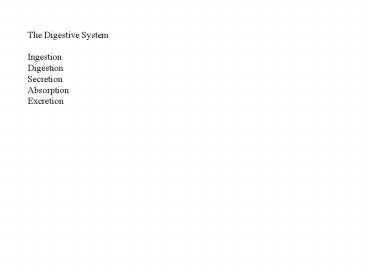The Digestive System - PowerPoint PPT Presentation
1 / 33
Title:
The Digestive System
Description:
Bacteria actually produce vitamins (B and K) Gas production by bacteria (from undigested ... Stores iron, vitamins, glycogen. Makes important blood proteins ... – PowerPoint PPT presentation
Number of Views:173
Avg rating:3.0/5.0
Title: The Digestive System
1
The Digestive System Ingestion Digestion Secretio
n Absorption Excretion
2
(No Transcript)
3
- What happens in digestion?
- Ingestion
- Mechanical (chewing)
- Chemical (enzymes)
4
(No Transcript)
5
(No Transcript)
6
Esophagus ca. 10 inches long peristalsis indepe
ndent of gravity False sphincter at junction
of esophagus and stomach
7
(No Transcript)
8
(No Transcript)
9
Empty stomach capacity is 50 ml Can expand to
hold several liters stretch receptors signal
HYPOTHALAMUS when stomach is full Hypothalamus-
a major control center in the brain hunger (and
satiety) thirst body temperature emotions memo
ry
10
(No Transcript)
11
Dr. William Beaumont, 1820s had a
unique opportunity to study the
stomach Contains acid Acid breaks down
protein Acid is produced when you eat Chewing
affects rate of digestion
12
Protein digestion starts in stomach (acid and
enzymes) Rennin and lipase help digest
milk Mucus protects stomach also epithelial
cells divide very rapidly Very little
absorption- aspirin and alcohol Taks 3-5 hours
to move to intestine
13
Heartburn- gastric juice (acid) backs up
into esophagus Bicarbonate- neutralize
acid Tagamet, Prilosec, Zantac- inhibit acid
formation Propulsid- acts on sphincter Peptic
ulcers- erosion of stomach lining bacterial
infection- H. pylori Product of stomach
digestion is called chyme- moves into small
intestine
14
(No Transcript)
15
Small intestine Digestion completed Absorption
Digestive enzymes come mostly from pancreas and
liver (recruited by small intestine) Proteases,
lipases, nucleases Bile
16
(No Transcript)
17
Gastrin promotes digestion of protein Cells in
small intestine secrete hormones CCK and
secretin These hormones cause pancreas to
secrete various digestive enzymes gallbladder
to secrete bile
18
(No Transcript)
19
Pancreatic juice contains several enzymes that
digest several kinds of molecules (see p.
414) also contains sodium bicarbonate to
neutralize acid Bile- helps with fat
digestion produced in liver, stored in
gallbladder
20
Large intestine Cecum, colon, anus Absorption
of water and a few other molecules Whats
left? undigested (indigestible)
food bacteria Bacteria actually produce
vitamins (B and K)
21
Gas production by bacteria (from
undigested food) Lactose intolerance- lack of
LACTASE (enzyme that breaks down lactose, a
milk sugar) Some bacteria make this enzyme
22
Diarrhea- too little water absorbed bacterial
toxins nervous stimulation can lead to
dehydration, electrolyte imbalance Constipation
not enough water intake behavioral dietary
23
After absorption into bloodstream- then
what? Goes to liver
24
(No Transcript)
25
Liver cleans up blood Stores iron, vitamins,
glycogen Makes important blood
proteins Controls blood cholesterol levels
26
Nutrition What do we need from
food? calories carbohydrates fats proteins vi
tamins minerals Food pyramid- out of date?
(USDA, 1992)
27
(No Transcript)
28
Carbohydrates Simple Complex other
nutrients fiber aids in digestion may help
reduce blood cholesterol
29
Carbohydrates and lipids can be stored in
the body. Proteins are not. Some amino acids
can be synthesized in the body eight cannot.
30
Sources of complete protein Animal
proteins Combinations of grains legumes nuts
and seeds vegetables
31
Lipids (fat and cholesterol) Saturated fats
raise blood cholesterol (LDL) some unsaturated
fats lower it Vitamins- coenzymes fat-soluble
(A, D, E, K) water-soluble (B vitamins, C)
32
Minerals many different types Too much or too
little can be harmful
33
Why do we need calories? How many do we need?































